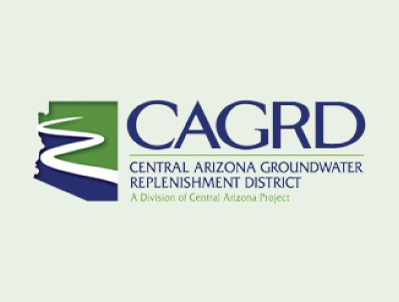
The Central Arizona Groundwater Replenishment District (CAGRD) was created by the Arizona Legislature in 1993. At that time, the Department of Water Resources was developing the Assured and Adequate Water Supply Rules. The AWS concepts under consideration included a significant commitment to use of renewable supplies, particularly in the Phoenix and Tucson Active Management Areas. Concerns were voiced. Without a mechanism that allowed for utilization of renewable supplies, many would face difficulty in demonstrating that their water use would be consistent with the statutory water management goal, a key requirement for a designation or certificate of Assured Water Supply.
The legislation creating the CAGRD was both innovative and complex. It established a mechanism for replenishing groundwater use without creating another layer of government. The replenishment responsibility was given to the operators of the Central Arizona Project. Every ten years, the CAGRD has to develop a plan of operation, which must be approved by the ADWR Director. The first plan was submitted in 1994, a year before the final approval of the AWS Rules.
Because the replenishment obligation could not have been projected with any accuracy, it is not surprising that a lot of guesswork went into the 1994 Plan. Where do we stand as the time for preparing the next plan approaches? The Plan’s high-end projection for 2001 replenishment for the Tucson AMA was over 9,000 acre feet (af). Actual replenishment in 2001 was approximately 6,400 af, including replenishment of 5,000 af for Tucson Water, pursuant to a specialized contract developed between the CAGRD and Tucson. Actual replenishment in the Phoenix AMA in 2001 was approximately 6,700 af, well above the 2,300 acre foot high-end projection included in the 1994 Plan. In the Pinal AMA, where replenishment demand is mitigated by the relatively large amount of groundwater use allowed by the AWS Rules, actual replenishment in 2001 was 20 percent above the high-end projection. Overall, total GRD replenishment in 2001 exceeded the high-end estimate included in the 1994 Plan by 15 percent. More significantly, projected total replenishment obligations for 2014 are now running 57,000 acre feet, far more than 37,500 af shown in 1994 as the high replenishment scenario. Is the rapid growth in replenishment obligation a cause for concern? It is not – if the CAGRD-related recommendations of the Governor’s Water Management Commission are implemented.
As discussed in my last column, the recommendations of the Commission were withdrawn from last session’s legislative agenda. It is expected that the recommendations specifically dealing with the CAGRD will be proposed again next year. If implemented, the most significant of these would establish a replenishment reserve of long-term storage credits. As noted in the Commission’s Final Report, in developing this recommendation, the challenge was “to provide a means of ensuring that the CAGRD can meet its long-term obligations, at a reasonable price, and still maintain the operational and legal flexibility to maximize the use of short-term supplies as they become available.”
Significant effort went into developing the replenishment reserve recommendation. It is important that the Legislature not delay consideration of the proposal beyond the 2003 legislative session. The CAGRD’s members can benefit from implementing this recommendation by taking advantage of the availability of surplus CAP water.
It should be noted that the replenishment reserve proposal was not developed primarily as a means for increasing the state’s utilization of CAP water while excess CAP water is available. The operations of the Arizona Water Banking Authority and the pricing policies of the CAWCD Board, in conjunction with increasing demand for renewable water supplies generally, have demonstrated that Arizona can utilize its full apportionment of CAP water. The proposal reflected legitimate concerns that, because the CAGRD allows for growth to occur without there being “firm” renewable water to supply that growth, there could be price shocks in the future for CAGRD members. What happens down the road when there is no surplus CAP water available? Will the CAGRD have planned for this eventuality and secured other supplies at reasonable cost? The replenishment reserve proposal was seen as a means of improving the reliability of the CAGRD and increasing the likelihood that the CAGRD’s rates remain stable in the future.
Does the replenishment reserve proposal, along with Commission recommendations for improved planning requirements and the ability for member service areas to de-enroll from the CAGRD, address all the concerns that have been voiced about the CAGRD? It does not, but it is a very significant start. Additional CAGRDrelated issues were identified, but there was not time for the Commission to examine them. Instead, the Commission recommended that the CAGRD Board address these additional issues through an appropriate public process. The issues include location of replenishment activities relative to the location of pumping, the need to obtain secure water supplies to meet the CAGRD’s future replenishment obligations, and the long-term role of the CAGRD. The CAGRD Board has already begun a process to follow up on this recommendation.
To date, the CAGRD has been successful in assisting developers and water providers in demonstrating that water use will be consistent with the state’s management goals. Implementing the replenishment reserve proposal, strengthening the CAGRD’s planning requirements, and examining the long-term role of the CAGRD will ensure that this success is continued into the future.

